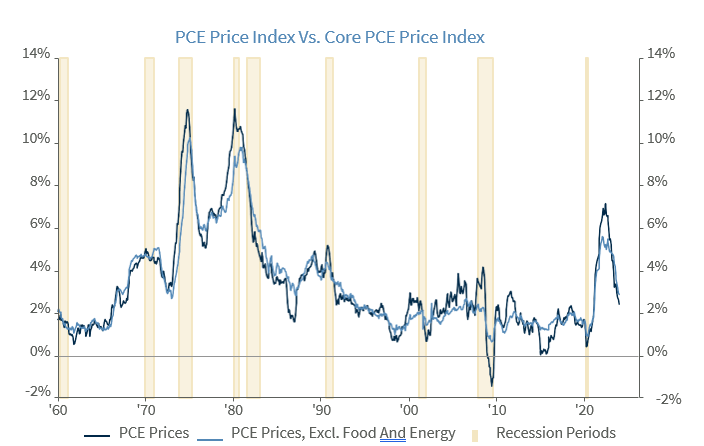ECONOMY & POLICY
Chief Economist Eugenio J. Alemán discusses current economic conditions.
Do you know that the headline Personal Consumption Expenditures (PCE) was 2.4% in January while the core PCE was 2.8%? This is very close to the 2% target. We are not saying the road ahead is not going to be bumpy for markets and for the Federal Reserve (Fed), but there is light at the end of the tunnel.
Since the start of the post-pandemic inflationary burst markets and analysts have been looking at both, the headline Consumer Price Index (CPI), and the headline PCE price indices. However, today, the Fed has a much more important concern than the headline PCE price index (and it actually could not care less about the headline CPI for policymaking). Although the headline PCE price index is important, it has a much more important concern.
The most important indicator for the Fed today when deciding when to start lowering interest rates would be the behavior of core inflation numbers, that is, inflation indices that do not include volatile food and energy prices. But particularly, it is going to look at what is happening to the core PCE price index while markets are probably going to use the core CPI price index to get a hint of what is going to happen to the core PCE price index, as these indices are released with about 15 days difference, which has made the CPI a ‘favorite’ for market analysts and reporters.
Thus, there are two basic reasons why markets and reporters favor the CPI release. First, it comes out early in the month, so it is probably a good indication of how hot or cold the PCE price index is going to be later in the month. But for us, perhaps the most important reason is the second one. Since February of 1959, the correlation between the headline CPI and the headline PCE price indices on a month-over-month basis has been 91.1%, which makes the CPI release a relatively good indication of what we should expect for the PCE price index, which is released later every month. Furthermore, once again, we have to point out that the weight of shelter costs in this index is about 33% compared to only about 13% for the PCE price index so, highly correlated but not the same. However, the core price indices are not as highly correlated as the headline price indices. The correlation between the core CPI and the core PCE price indices since February of 1959 is ‘just’ 78%, still high but not as high as the correlation between the headline CPI and PCE price indices. That is, close, but not that close.
But most importantly, what the Fed is going to focus on during the next several months is what happens with the year-over-year rate of headline inflation (both CPI as well as PCE) versus what is happening with the year-over-year rate in the core CPI as well as core PCE. We continue to prefer the core PCE because it will be what Fed official will focus on going forward and the preferred characteristics of the PCE price index versus the CPI, which we have written about in previous weeklies, added to the fact that the PCE price index is the target the Fed uses to conduct monetary policy.
February’s CPI report is a clear example of what we are talking about. Monthly headline and core prices were both up 0.4% on a seasonally adjusted basis. However, the year-over-year headline rate of inflation increased from 3.1% in January to 3.2% in February while the year-over-year core CPI went down, from a 4.9% rate in January to a 4.8% rate in February. That is, even if the direction of the headline number disappointed, the direction of the core measure continued to move down, even if the month-over-month core CPI was higher than what markets were expecting.
Of course, the core inflation measures will benefit from those sectors that have remained relatively sticky to the downside, like shelter costs and overall services prices so the path forward for core prices is going to remain treacherous, but as long as the Fed continues to see improvement in the core measures going forward, it will become more confident that inflation will remain under control and thus will be willing to start to lower interest rates as soon as midyear.
Economic and market conditions are subject to change.
Opinions are those of Investment Strategy and not necessarily those of Raymond James and are subject to change without notice. The information has been obtained from sources considered to be reliable, but we do not guarantee that the foregoing material is accurate or complete. There is no assurance any of the trends mentioned will continue or forecasts will occur. Last performance may not be indicative of future results.
Consumer Price Index is a measure of inflation compiled by the US Bureau of Labor Statistics. Currencies investing is generally considered speculative because of the significant potential for investment loss. Their markets are likely to be volatile and there may be sharp price fluctuations even during periods when prices overall are rising.
Consumer Sentiment is a consumer confidence index published monthly by the University of Michigan. The index is normalized to have a value of 100 in the first quarter of 1966. Each month at least 500 telephone interviews are conducted of a contiguous United States sample.
Personal Consumption Expenditures Price Index (PCE): The PCE is a measure of the prices that people living in the United States, or those buying on their behalf, pay for goods and services. The change in the PCE price index is known for capturing inflation (or deflation) across a wide range of consumer expenses and reflecting changes in consumer behavior.
The Consumer Confidence Index (CCI) is a survey, administered by The Conference Board, that measures how optimistic or pessimistic consumers are regarding their expected financial situation. A value above 100 signals a boost in the consumers’ confidence towards the future economic situation, as a consequence of which they are less prone to save, and more inclined to consume. The opposite applies to values under 100.
Certified Financial Planner Board of Standards Inc. owns the certification marks CFP®, CERTIFIED FINANCIAL PLANNER™, CFP® (with plaque design) and CFP® (with flame design) in the U.S., which it awards to individuals who successfully complete CFP Board’s initial and ongoing certification requirements.
Links are being provided for information purposes only. Raymond James is not affiliated with and does not endorse, authorize or sponsor any of the listed websites or their respective sponsors. Raymond James is not responsible for the content of any website or the collection or use of information regarding any website’s users and/or members.
GDP Price Index: A measure of inflation in the prices of goods and services produced in the United States. The gross domestic product price index includes the prices of U.S. goods and services exported to other countries. The prices that Americans pay for imports aren’t part of this index.
The Conference Board Leading Economic Index: Intended to forecast future economic activity, it is calculated from the values of ten key variables.
The Conference Board Coincident Economic Index: An index published by the Conference Board that provides a broad-based measurement of current economic conditions.
The Conference Board lagging Economic Index: an index published monthly by the Conference Board, used to confirm and assess the direction of the economy’s movements over recent months.
The U.S. Dollar Index is an index of the value of the United States dollar relative to a basket of foreign currencies, often referred to as a basket of U.S. trade partners’ currencies. The Index goes up when the U.S. dollar gains “strength” when compared to other currencies.
The FHFA House Price Index (FHFA HPI®) is a comprehensive collection of public, freely available house price indexes that measure changes in single-family home values based on data from all 50 states and over 400 American cities that extend back to the mid-1970s.
Import Price Index: The import price index measure price changes in goods or services purchased from abroad by U.S. residents (imports) and sold to foreign buyers (exports). The indexes are updated once a month by the Bureau of Labor Statistics (BLS) International Price Program (IPP).
ISM New Orders Index: ISM New Order Index shows the number of new orders from customers of manufacturing firms reported by survey respondents compared to the previous month. ISM Employment Index: The ISM Manufacturing Employment Index is a component of the Manufacturing Purchasing Managers Index and reflects employment changes from industrial companies.
ISM Inventories Index: The ISM manufacturing index is a composite index that gives equal weighting to new orders, production, employment, supplier deliveries, and inventories.
ISM Production Index: The ISM manufacturing index or PMI measures the change in production levels across the U.S. economy from month to month.
ISM Services PMI Index: The Institute of Supply Management (ISM) Non-Manufacturing Purchasing Managers’ Index (PMI) (also known as the ISM Services PMI) report on Business, a composite index is calculated as an indicator of the overall economic condition for the non-manufacturing sector.
Consumer Price Index (CPI) A consumer price index is a price index, the price of a weighted average market basket of consumer goods and services purchased by households. Changes in measured CPI track changes in prices over time.
Producer Price Index: A producer price index (PPI) is a price index that measures the average changes in prices received by domestic producers for their output.
Industrial production: Industrial production is a measure of output of the industrial sector of the economy. The industrial sector includes manufacturing, mining, and utilities. Although these sectors contribute only a small portion of gross domestic product, they are highly sensitive to interest rates and consumer demand.
The NAHB/Wells Fargo Housing Opportunity Index (HOI) for a given area is defined as the share of homes sold in that area that would have been affordable to a family earning the local median income, based on standard mortgage underwriting criteria.
The S&P CoreLogic Case-Shiller U.S. National Home Price NSA Index measures the change in the value of the U.S. residential housing market by tracking the purchase prices of single-family homes.
The S&P CoreLogic Case-Shiller 20-City Composite Home Price NSA Index seeks to measures the value of residential real estate in 20 major U.S. metropolitan.
Source: FactSet, data as of 7/7/2023

